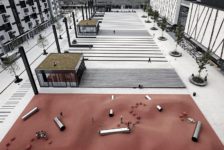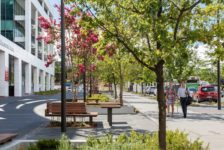Article by Farah Afza Jurekh In this article we look at the fundamentals of universal design. Universal accessibility is widely considered by landscape architects. However, beyond functional elements such as crosswalks with sound cues, there are very few landscapes that are designed to engage the senses and provide benefits to the visually impaired. Landscape design principles offer an array of opportunities to the people who are visually impaired and physically challenged to ensure their ease in movement and comfort. Visually Impaired People When visually impaired people negotiate with the outside world, their hands and feet become their eyes. They use their feet to acquire surface information and fingers to recognize texture, form, and location. Additionally, the blind rely on other sensory organs to compensate for their lack of sight and their ability to hear, smell, taste, touch, and feel is more subtle than people with sight. By manipulating certain aspects of the landscape, a person who is visually impaired or physically challenged could have an enhanced perception of the surrounding environment. Sites that accentuate non-visual experiences can foster feelings of security, both physical and psychological, by creating alternative prompts and allowing them to navigate and identify spaces that may not be familiar. Importance of Tactile Surfaces Especially for Physically Challenged People Texture Texture, for this purpose, refers to ground surfaces, which can be used to denote footpaths for visually impaired people through their sense of touch. They are detected either underfoot or via a walking cane. Furthermore, changes in ground surface can be used to indicate an approaching hazardous area, such as a road or signal crossing, and show the correct direction to proceed.

ADA compliant color contrast detectable warning installation on a high traffic area in New York City. Credit: CC BY 3.0
The slope, or the gradient of a ramp, should be designed to local guidelines. This is essential for wheelchair users where there are level changes between streets and sidewalks. In some countries, these curbs are equipped with audio systems that emit a warning sound when they are crossing roads.
Varying Textures Can be a Key Design Tool Tactile paving surfaces can also be used to convey critical information about the location of amenities such as stairs, telephone booths, benches, etc. In this case, changing texture is used to stimulate their attention.

Low profile directional tactile markings are installed on busy pedestrian crossings in Japan. Credit: CC BY-SA 3.0
Living textures are another way to enhance the experience for the visually impaired. Living textures refer to the feel of plants and trees. Apart from the feel, the fragrance can also be of assistance.
Shrubs The chirping of birds can help the visually impaired identify places. With the use of more shrubs, more birds may be invited to flock around. A few recommended species include arrowwood
, winterberry holly
, and common snowberry.
Scented Plants Although these are only a few common examples, the choice of trees and plant species vary by region. Species should be selected based on their hardiness to the region’s climatic conditions. Examples include cherry plum, maple, tulip apricot beauty, and Arum maackia. Smell and sound also help visually impaired people. In addition to the aesthetic enrichment these plants provide, fragrant plants and the sound produced from the movement of trees and shrubs may aid the visually impaired, providing them with a reference to make judgments about their surroundings.

The future approach to Brickell Station along Miami’s Underline. Credit: James Corner Field Operations, courtesy Friends of the Underline
Vertical elements like walls with rough surfaces and other landscape elements such as statues and landmarks may convey information to the visually impaired through touch.
Splashing Water Amidst Noisy Distractions Can Help Them Identify Places Another feature that can be used to trigger one’s sensory perception is water. Landscape architects love incorporating water into their designs. It not only provides a cooling effect, but can also create a vibrant ambience. Similarly, the use of fountains and the sound of splashing water can support the visually impaired to recognize places through listening
. The Use of Legible Signage and Interactive Artwork Signs and signage are important components in urban design. The legibility of signs and signage and interactive artwork can provide the physically impaired with tactile surfaces, which can be perceived by touch. Next time you’re tasked with a universal design project, consider implementing different textured pavements, fragrant trees and plants, street furniture, and splashing water. These are just a few examples that landscape architects can employ to allow the visually impaired and physically challenged to move independently at ease.
Do you think these ideas help? Please share your thoughts on how landscape architects can improve universal design. — Featured image: Malecón Walk | Puerto Vallarta, Mexico | West 8 | 2011
Published in Blog














